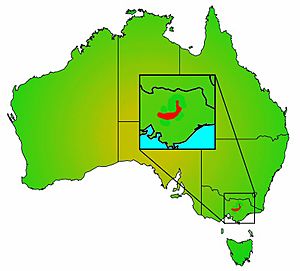Barred galaxias facts for kids
Quick facts for kids Barred galaxias |
|
|---|---|
| Conservation status | |
| Scientific classification | |
| Kingdom: | |
| Phylum: | |
| Class: | |
| Order: |
Osmeriformes
|
| Family: | |
| Subfamily: | |
| Genus: |
Galaxias
|
| Species: |
G. fuscus
|
| Binomial name | |
| Galaxias fuscus Mack, 1936
|
|
The barred galaxias (scientific name: Galaxias fuscus) is a small, freshwater fish. It belongs to a group of fish called galaxiids. You can find this special fish in Australia. It's part of the "Mountain Galaxias" family of fish.
Contents
What Does the Barred Galaxias Look Like?
The barred galaxias is a freshwater fish. It has a body shape typical of its family, Galaxias. Its fins are usually larger and more rounded than other fish in its group.
This fish can grow up to about 6.5 inches (165 mm) long. Most often, they are around 3 to 4 inches (80-105 mm) long. Their body color is usually yellow-orange to red-orange.
Unique Markings
A cool thing about these fish is their dark, vertical bars. These bars are unevenly spaced and can vary in number. They are often rounded at the top and pointy at the bottom, like an upside-down teardrop.
Some fish might have no bars, while others can have up to ten. Usually, they have fewer than seven bars. The bars might even look different on each side of the fish! Their head and upper body often have a shadowy look from many small dark grey spots. Around the side bars, there's often a lighter "halo" where the spots aren't present. This shows off their bright base color.
Where Does the Barred Galaxias Live?
The barred galaxias lives in a specific part of Australia. You can find it in the upper areas of the Goulburn River system. This river is north of the Great Dividing Range. It's also part of the larger Murray–Darling basin.
High Up in the Mountains
These fish live in places that are quite high up. They are found at elevations between 1,300 and 5,250 feet (400–1600 meters) above sea level. This area is about 47 miles (75 km) northeast of Melbourne.
Sadly, the barred galaxias used to live in more places. It is now gone from areas like the lower Rubicon River and Mountain Creek. It also disappeared from Whitehouse Creek and Gaffneys Creek. This fish can only survive in places where there are no trout.
What Kind of Home Does It Like?
The barred galaxias prefers small, shallow rivers and creeks. These waterways are often overgrown with plants. The water usually flows at a moderate to fast speed. It also needs the water to be cool or cold.
Riverbed and Shelter
The bottom of these streams is made of different materials. You'll find bedrock, large and small stones, pebbles, gravel, and sand. For shelter, the fish use large and small pieces of wood. They also hide among rocks and tree roots that stick out from the banks. The water temperature in their home usually stays below 59°F (15°C).
How Does the Barred Galaxias Reproduce?
Barred galaxias fish lay their eggs in late September to early October. Their eggs are small, about 0.08 inches (2.2 mm) across. These eggs are sticky and are laid on the sides or underneath rocks. They choose spots where the water is fast and shallow.
Hatching and Surviving Winter
The eggs hatch in about one month. The baby fish, called larvae, are very tiny. They are only about 0.3 to 0.5 inches (8-12 mm) long when they first hatch. These fish are very tough. They can handle extremely cold water, even below 37°F (3°C). This includes areas near and just below the snowline in winter.
Why Is the Barred Galaxias Protected?
The barred galaxias is a special fish that needs our help. It is protected by important laws in Australia. These laws include the national Environment Protection and Biodiversity Conservation Act 1999. It is also protected by Victoria's Flora and Fauna Guarantee Act 1988.
Endangered Status
Because its numbers are low, the barred galaxias is listed as "endangered." This means it is at a very high risk of becoming extinct in the wild. This listing is done by the IUCN Red List, which tracks threatened species around the world.
Is It Used by Humans?
The barred galaxias is not a fish that people try to catch for sport. This is because it is quite small. Also, it is an endangered species, so it is important to protect it.



